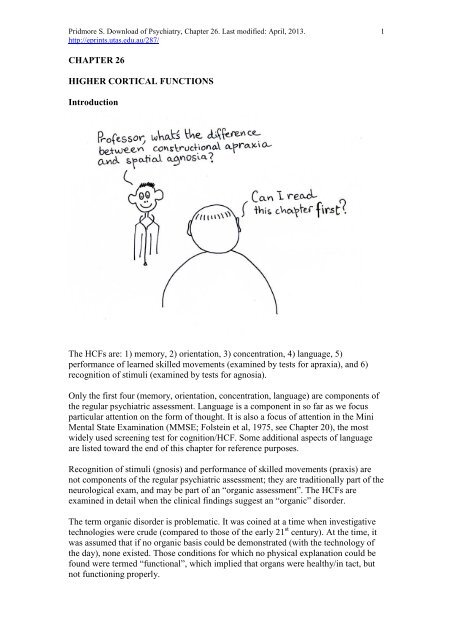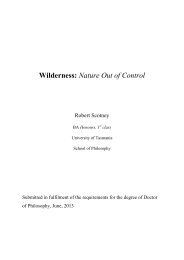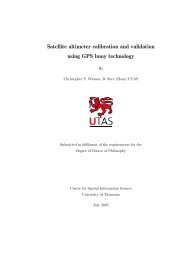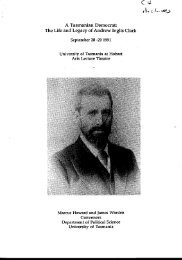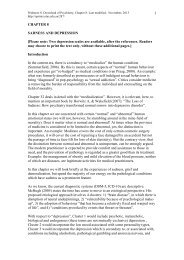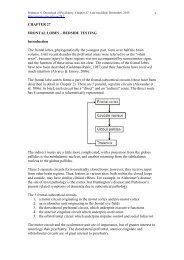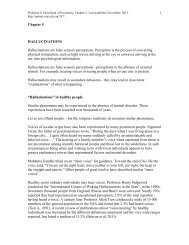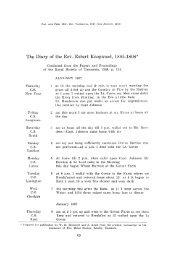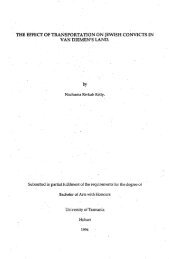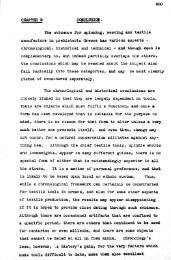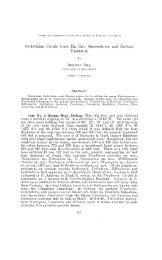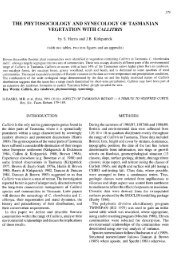CHAPTER 26 HIGHER CORTICAL FUNCTIONS ... - UTas ePrints
CHAPTER 26 HIGHER CORTICAL FUNCTIONS ... - UTas ePrints
CHAPTER 26 HIGHER CORTICAL FUNCTIONS ... - UTas ePrints
Create successful ePaper yourself
Turn your PDF publications into a flip-book with our unique Google optimized e-Paper software.
Pridmore S. Download of Psychiatry, Chapter <strong>26</strong>. Last modified: April, 2013.<br />
http://eprints.utas.edu.au/287/<br />
<strong>CHAPTER</strong> <strong>26</strong><br />
<strong>HIGHER</strong> <strong>CORTICAL</strong> <strong>FUNCTIONS</strong><br />
Introduction<br />
The HCFs are: 1) memory, 2) orientation, 3) concentration, 4) language, 5)<br />
performance of learned skilled movements (examined by tests for apraxia), and 6)<br />
recognition of stimuli (examined by tests for agnosia).<br />
Only the first four (memory, orientation, concentration, language) are components of<br />
the regular psychiatric assessment. Language is a component in so far as we focus<br />
particular attention on the form of thought. It is also a focus of attention in the Mini<br />
Mental State Examination (MMSE; Folstein et al, 1975, see Chapter 20), the most<br />
widely used screening test for cognition/HCF. Some additional aspects of language<br />
are listed toward the end of this chapter for reference purposes.<br />
Recognition of stimuli (gnosis) and performance of skilled movements (praxis) are<br />
not components of the regular psychiatric assessment; they are traditionally part of the<br />
neurological exam, and may be part of an “organic assessment”. The HCFs are<br />
examined in detail when the clinical findings suggest an “organic” disorder.<br />
The term organic disorder is problematic. It was coined at a time when investigative<br />
technologies were crude (compared to those of the early 21 st century). At the time, it<br />
was assumed that if no organic basis could be demonstrated (with the technology of<br />
the day), none existed. Those conditions for which no physical explanation could be<br />
found were termed “functional”, which implied that organs were healthy/in tact, but<br />
not functioning properly.<br />
1
Pridmore S. Download of Psychiatry, Chapter <strong>26</strong>. Last modified: April, 2013.<br />
http://eprints.utas.edu.au/287/<br />
With technological advances, the boundaries of “organic” should be moved.<br />
Schizophrenia, for example, was considered to be a functional disorder, but imaging<br />
and genetic studies have clearly demonstrated a physical basis. The same applies to<br />
many other psychiatric disorders.<br />
The term organic, therefore, says more about the technology of the day than the<br />
existence of pathology. It can be argued that psychiatry is generally concerned with<br />
pathology at a molecular level (e.g., neurotransmitters) and other branches of<br />
medicine are concerned with supra-molecular pathology (e.g., abnormal cells, as in<br />
tumour), but this is an over-simplification. For example, the ‘neurological’ disorder,<br />
Parkinson’s disease, is a result of reduced availability of the neurotransmitter<br />
dopamine, in the nigrostriatal tract, while the ‘psychiatric’ disorder, schizophrenia<br />
appears, at least in part, to involve variations in the availability of dopamine in the<br />
mesolimbic tract.<br />
Putting confusing terminology aside: HCF testing is a valuable means of detecting<br />
conditions which may present as psychiatric disorders but which require the services<br />
of other branches of medicine. For example, patients may present with a picture<br />
suggestive of schizophrenia or depression which is secondary to space occupying<br />
lesions, toxic, endocrine or metabolic abnormalities, and in such circumstances, HCF<br />
testing frequently reveals abnormalities.<br />
In general, if memory, orientation, concentration and language are intact, the<br />
performance of learned skilled movements and recognition of stimuli will also be<br />
intact. Thus, the former may be regarded as a screening test, such that if they are<br />
intact, the latter need not be tested.<br />
MMSE deserves special mention. This is a standardised, widely employed screening<br />
test of HCF. It examines orientation in some detail and then briefly touches on<br />
registration and recall, attention/concentration, language and constructional abilities.<br />
Brevity is its strength (allowing wide breadth examination) and its weakness (not<br />
providing a comprehensive assessment). This is a screening test which may be used to<br />
indicate whether more extensive (time consuming) examination is necessary.<br />
Memory<br />
Memory is the ability to revive past thoughts and sensory experiences. It includes<br />
three basic mental processes: registration (the ability to perceive, recognise, and<br />
establish information in the central nervous system), retention (the ability to retain<br />
registered information) and recall (the ability to retrieve stored information at will).<br />
Short-term memory (which for this discussion includes what has been called<br />
immediate memory by others) has been defined as the recall of material within a<br />
period of up to 30 seconds after presentation. Intuitively, there is something different<br />
between short tem and long term memory. At the library, there is something different<br />
between the daily newspapers which are displayed on a table in the foyer, and those of<br />
last year which are stored out of sight in the basement.<br />
2
Pridmore S. Download of Psychiatry, Chapter <strong>26</strong>. Last modified: April, 2013.<br />
http://eprints.utas.edu.au/287/<br />
Long term memory can be split into recent memory (events occurring during the<br />
past few hours to the past few months) and remote memory (events occurring in past<br />
years).<br />
Memory can be influenced by many factors. In addition to physical lesions,<br />
intoxication, emotional arousal, psychomotor retardation, thought disorder and<br />
motivation must be considered.<br />
Tests of memory<br />
During the psychiatric interview good information about memory is available.<br />
Memory testing provides quantification (but this may not be necessary).<br />
Three levels of memory are specifically tested.<br />
There should be concern for the patient’s comfort and dignity, but there should not be<br />
indecision or inappropriate apology. After some general conversation, the examiner<br />
may say something like, “Thank you Mr X, I understand what you have been saying. I<br />
now need to test your memory.” Then proceed directly to, “I am going to give you<br />
three things which I want you to remember.......” or similar words, according to the<br />
test the examiner wishes to apply.<br />
When a patient who has been treated respectfully but makes excuses or refuses<br />
cognitive testing, there is probably cognitive impairment. [The impression is that at<br />
some level, the patient is aware of reduced ability, and refuses testing to avoid the<br />
experience of failure.]<br />
History and conversation<br />
The patient should be able to give a clear account of his/her life from the remote to<br />
the recent past.<br />
The presenting complaint is important. Where memory function is the primary<br />
problem the patient may not be able to remember why he/she is present. The patient<br />
should be able to give details of who made the arrangements for the interview, how<br />
she/he was conveyed from home or work, at what time did he/she depart home or<br />
work, at what time did he/she arrive and how long the journey took. Thus, the history<br />
gives the opportunity for a real life test of the recent memory.<br />
From the history, assessment of the remote memory may be difficult as the examiner<br />
does not have many (if any) of the facts of the patient’s life. Internal consistency of<br />
the personal history, however, may give important information. That is, do the dates,<br />
ages and events match up, when patient describes her/his past life. The names and<br />
current ages of children and siblings are often useful questions. An alarm goes off if a<br />
70 year old appears to have little idea of the age of her/his children.<br />
Short-term (immediate) memory test<br />
The most common test is to ask the patient to repeat sequences of digits. Three digits<br />
are given first and the patient is asked to repeat them. If this is performed<br />
successfully, four digits are given and so on, until the patient makes mistakes. A<br />
healthy person of average intelligence is usually able to repeat seven digits correctly.<br />
3
Pridmore S. Download of Psychiatry, Chapter <strong>26</strong>. Last modified: April, 2013.<br />
http://eprints.utas.edu.au/287/<br />
(Strictly speaking, this is not memory, as this information is kept in mind and does not<br />
have to be retrieved.)<br />
Recent memory test<br />
A common testing method is to ask the patient to learn three or four unrelated words.<br />
The patient is advised that she/he will be given some words to remember, and that<br />
later in the interview she/he will be asked to recall them. The words are said (e.g., a<br />
car, a tree, a sock, a bucket) at the rate of about one second per second. The patient is<br />
asked to repeat each word after it has been said, to ensure that each has been<br />
registered properly. The interview then proceeds so that the patient is distracted. Some<br />
minutes later the patient is asked to recall the words. If any words cannot be recalled,<br />
the test can be re-administered using a different set of words. The score is kept, “the<br />
patient remembered two out of four items”.<br />
Remote memory test<br />
The examiner usually does not have extensive knowledge of the patient’s past life<br />
against which to check any answers. Individual differences in intelligence and<br />
education make it difficult to know what questions on past world events are<br />
reasonable to ask.<br />
The date of birth is often available to the examiner. However, this is very highly<br />
learned material, it is among the last pieces of information to be lost and its retention<br />
does not exclude moderately severe memory problems.<br />
The names and dates of birth of the patient’s children may also be available, as might<br />
the patient’s partner/spouse and mother’s maiden names.<br />
It is reasonable to ask the capital cities of Australia, England and USA, and perhaps<br />
the dates of the first and second world wars - taking care to consider intelligence and<br />
education levels.<br />
It is reasonable to ask the name of the current Prime Minister or President. Often<br />
patients with memory problems give the name of a Prime Minister or President from<br />
the past – in this case, in clinical experience, the more remote in time the named<br />
person held office, the greater the memory problems.<br />
Loss of memory/Amnesia - clinical pictures<br />
Loss of memory of organic origin<br />
Dementia<br />
Dementia (see Chapter 20) is a global deterioration in intellectual functioning, a<br />
central feature of which is memory problems. It is usually of gradual onset, although<br />
it may follow sudden events such as head injury. In general, the more recently stored<br />
the more rapidly lost; memories stored long ago are lost last. However, this is a<br />
relative matter and the remote memory of patients with dementia is usually<br />
significantly impaired compared to that of non-demented persons or comparable age.<br />
There is also impairment in abstract thinking, judgement, other cortical functions and<br />
personality change.<br />
4
Pridmore S. Download of Psychiatry, Chapter <strong>26</strong>. Last modified: April, 2013.<br />
http://eprints.utas.edu.au/287/<br />
Amnestic disorder (Korsakoff’s psychosis/syndrome)<br />
Korsakoff’s amnestic disorder is characterised by the inability to learn new<br />
information, while other HCFs are retained. Lack of motivation and flat affect are<br />
common. Patients frequently lack insight and deny difficulties. Confabulation (untrue<br />
experiences which the patient believes) may occur in the early stages but this curious<br />
sign usually declines over time. Confabulation is different in nature to delusion, the<br />
confabulation may change at every meeting, it is usually friendly and often claims a<br />
previous friendly acquaintance with the interviewer (“Yes, of course I remember you,<br />
we’ve played golf together for years”). The impression is that the ideas flood in to fill<br />
a memory vacuum.<br />
The patient with Korsakoff’s syndrome is severely disabled, and frequently incapable<br />
of independent living.<br />
The most common cause of amnestic disorder is thiamine deficiency secondary to<br />
alcohol use - in which case onset may be gradual, or more apparently rapid if it arises<br />
in a setting of acute Wernicke's encephalopathy. Head injury, cerebral neoplasm,<br />
carbon monoxide poisoning and herpes simplex encephalitis are other causes.<br />
Loss of memory of psychological origin<br />
Psychogenic amnesia<br />
In psychogenic amnesia the predominant disturbance is an episode of sudden inability<br />
to recall important personal information, which is not due to an organic mental<br />
disorder. (The usual presentation is distinct from Korsakoff’s amnesia where the<br />
difficulty is in learning new information.) Onset is sudden and there is usually some<br />
precipitating emotional trauma. The psychogenic amnesias are reversible.<br />
The clinical presentation is compounded by the combination of unconscious<br />
forgetting and active avoidance of painful material. The memories lost and the<br />
understanding of the patient of their condition usually varies with time and<br />
circumstances. Unlike organic amnesia, the ability to learn new material is usually<br />
retained. Malingering must be excluded.<br />
Orientation<br />
In the psychiatric examination, orientation means awareness of one's relationships and<br />
surroundings in time, place and person. Insofar as disorientated people are frequently<br />
given orienting information by other individuals, but remain disorientated, the<br />
condition has a memory component.<br />
Orientation in time<br />
Orientation in time is often the first dimension to be lost and the last to return. As with<br />
memory, it is the recent, more precise information, which is lost first. The patient is<br />
asked to give the year, month, day of the week and date.<br />
Even more fine-grained information is the time of day. Clinical experience is that<br />
disorientated patients often give answers which are inconsistent with the evidence.<br />
5
Pridmore S. Download of Psychiatry, Chapter <strong>26</strong>. Last modified: April, 2013.<br />
http://eprints.utas.edu.au/287/<br />
They may contend it is evening even when the sun is blazing through the window, and<br />
may not change their answer when these inconsistencies are pointed out. When trying<br />
to help the patient with the time of day the examiner may ask which meals of the day<br />
the patient has eaten. This is a test of memory, but may be asked here - the patient<br />
may claim that it is late afternoon - but that breakfast has not yet been served.<br />
Orientation in place<br />
The MMSE contains some good orientation in place questions. At the “big picture”<br />
end, the questions are about identifying the city and the county. If a patient knows the<br />
city, knowing the county is a matter of memory, rather than orientation.<br />
Going on from other questions the examiner can say something like, “Well, thank you<br />
for helping me with those questions, Mrs Z. Now, I would like to ask you, can you<br />
please tell me, the name of the city (or building) we are in?”<br />
If the patient is not able to give the name of the building, or gives an incorrect answer<br />
it is important to determine whether she/he can benefit from the cues around them. If<br />
they answer that they are in their own home, it is reasonable to say something like,<br />
“I'm not sure this is your house. Is this your furniture? There seem to be other people<br />
walking around. Are you sure this is your home?”<br />
If the patient says she/he does not know where she/he is, the same sort of questions as<br />
in the above paragraph should be asked. It is reasonable to say something like, “Mr Y,<br />
we are in a public building. It could be a police station, a railway station, a fire station<br />
or a hospital. Have a look around. Look at the beds and the people walking around. In<br />
which one of those places do you think we are?”<br />
The patient gives the name of the facility/hospital correctly, she/he should then be<br />
asked to name the ward. If this cannot be given, the patient should be asked what type<br />
of cases are treated on this ward. If there are difficulties with this question, ask the<br />
patient to look around, “You are right about this being a ward of the Royal Hospital.<br />
But, what type of ward is this? Have a look around, the patients don’t seem to be in<br />
bed here. Do you think this is a surgical ward where people are recovering from<br />
operations?”<br />
Orientation in person<br />
Orientation in person requires various abilities, including the capacity to recognise<br />
faces (prosopagnosia being agnosia for faces) and memory. Thus, failure in<br />
orientation in person is a general rather than specific indicator of pathology.<br />
Under this heading the examiner assesses the patient’s ability to identify her/himself,<br />
but more importantly, others. A common mistake is to report only on the patient's<br />
ability to give her/his own name.<br />
The patient may then be asked to identify the examiner, who will have introduced<br />
him/herself earlier (and may have been known from previous meetings) and to<br />
indicate the type of work the examiner performs. The patient may say that she/he has<br />
a poor head for names. In this case it is better to move to the examiners function, by<br />
saying something like, “Yes, I’m not much good on names myself. But we’ve been<br />
6
Pridmore S. Download of Psychiatry, Chapter <strong>26</strong>. Last modified: April, 2013.<br />
http://eprints.utas.edu.au/287/<br />
talking about things for a few minutes, Mr X.....Can you tell me what sort of work I<br />
do?”<br />
When testing orientation in person it is often worth asking the patient to identify by<br />
name and occupation, any available nursing staff who have had dealing with her/him<br />
and to identify any available relatives.<br />
Attention (Concentration)<br />
The term ‘concentration’ has traditionally been used in the standard psychiatric<br />
assessment. This is being replaced by the term “attention”.<br />
Attention is a multifaceted mental function, but in general, it denotes the capacity of<br />
an individual to focus the mind on (pay attention to) some aspect of the environment<br />
or the contents of the mind itself (Cutting, 1992).<br />
Tests of attention<br />
History and conversation<br />
Patients often lack insight into their difficulties with attention (as mentioned, they are<br />
usually more familiar with the word concentration). The experience of poor attention<br />
is often unpleasant. Where the symptom is suspected, it is reasonable to ask, “Mr X<br />
how is your concentration at the moment. Are you able to watch a show on TV and<br />
concentrate all the way through?” (Alternatively, “Are you able to concentrate on<br />
reading the newspaper?”)<br />
Where there are marked difficulties with attention, this will be obvious during<br />
conversation. The patient will be unable to give a clear account of the reasons for<br />
presentation, will wander off the topic and will be distracted by the external<br />
environment and her/his own thoughts. It may, in the early stages, be difficult to<br />
distinguish the person with schizophrenia and severe formal thought disorder from the<br />
person with delirium.<br />
Subtraction<br />
A common test is to ask the patient to take seven from one hundred and keep<br />
subtracting seven from the answer. There is no accepted standard for the number of<br />
mistakes and the amount of time allowed. A written record of the performance is<br />
useful, particularly when a problem is suspected, as this allows the ability to be retested<br />
on a later occasion and comparisons to be made. Even without an agreed<br />
standard, it is often possible to identify impaired ability. The patient may not even get<br />
the first subtraction correct. Quite often an impaired patient will perform a number of<br />
subtractions (often with mistakes) and then start making additions.<br />
If the patient has had little numerical education, it may be appropriate to give an<br />
easier task. Subtracting three from twenty down to zero is easier. Subtracting two<br />
from twenty is easier again. It is important only that the task taxes the patient so that<br />
her/his ability to sustain attention can be evaluated.<br />
7
Pridmore S. Download of Psychiatry, Chapter <strong>26</strong>. Last modified: April, 2013.<br />
http://eprints.utas.edu.au/287/<br />
Reversing components<br />
Reversing a series of numbers is a commonly used test of attention. The examiner<br />
reads the numbers to the patient slowly and clearly. Again, it is not clear what<br />
constitutes normal and pathological performances.<br />
Reversing the letters of a “world” is stated to be an alternative to the 100 minus 7 test<br />
in the MMSE. However, in this test the patient should be comfortable with the<br />
forward arrangement of the letters. The examiner should first say the word, and have<br />
the patient spell the word forwards before attempting to reverse the letters.<br />
Reversing the months of the year is another recommended test. A problem with this is<br />
test is that some students learn this task by rote at school, while others do not. For<br />
those without rote learning, reversing the months of the year can be quite difficult. An<br />
easier task is to reverse the days of the week. This may too easy - it can be made more<br />
taxing by asking the patient to reverse the days of the week for a fortnight. If the<br />
impaired patient makes a start on this test, they often fail to continue into a second<br />
week.<br />
Other HCFs<br />
Medical students and trainee psychiatrists should be competent in the above. The<br />
material from this point on, however, is more esoteric and forms part of a more<br />
comprehensive assessment, and is included for reference purposes only. Various<br />
experts may be involved in such an assessment: psychiatrist, neuropsychiatrist,<br />
neurologist, behavioural neurologist, neuropsychologist and speech pathologist.<br />
Language<br />
Language is assessed in the standard psychiatric assessment through attention to the<br />
form of thought, and is a significant component of the MMSE. Thus, language could<br />
be placed in the group above, but the aspects of language assessment are not part of<br />
the standard psychiatric assessment.<br />
Aphasia<br />
Aphasia is the loss or impairment of language caused by brain damage (Benson,<br />
1992). The specific mention of the presence of brain damage prohibits the use of this<br />
term in the so-called ‘functional disorders’ (such as schizophrenia). Another<br />
definition is interesting: “a disorder of the symbolic functions of speech”. This would<br />
make aphasia indistinguishable from the formal thought disorder of schizophrenia –<br />
but let us not embroil ourselves in a pointless debate.<br />
Broca's aphasia<br />
In Broca's aphasia the output is sparse, effortful (the patient struggles), dysarthric,<br />
dysprosodic, short-phrased and agrammatic. There is disturbance in repetition and<br />
naming. Comprehension is relatively preserved. The patient may be aware of and<br />
frustrated by her/his expressive difficulties. This form is associated with damage to<br />
the posterior inferior frontal gyrus (in the region of the operculum) of the dominant<br />
hemisphere.<br />
8
Pridmore S. Download of Psychiatry, Chapter <strong>26</strong>. Last modified: April, 2013.<br />
http://eprints.utas.edu.au/287/<br />
Wernicke's aphasia<br />
In Wernicke's aphasia there is fluent verbal output with normal word count and phrase<br />
length and no effort or articulatory problems, but there is difficulty in word finding<br />
and frequent paraphasia (unintentional syllables, words or phrases during speech).<br />
The patient may be unaware of her/his difficulties and frustrated by the failure of<br />
others to respond appropriately. This form is associated with lesions of the posterior<br />
superior temporal lobe of the dominant hemisphere.<br />
Nominal aphasia<br />
In anomic aphasia the primary problem is with word finding. There are frequent<br />
pauses and a stumbling output. There may be reading and writing disturbance. Output<br />
may be fluent and comprehension good, but with naming significantly disturbed. This<br />
is often the residuum when other aphasias have largely resolved.<br />
Other forms of aphasia<br />
Additional forms include conductional aphasia and transcortical aphasia.<br />
Examining aphasia<br />
Observations are made during introductory conversation and history gathering. If<br />
indicated, the following may be tested.<br />
Dysarthria<br />
Dysarthria (speech disorder due to organic disorders of the speech organs or nervous<br />
system) is a mechanical problem. It is not a form of aphasia, but as it frequently coexists<br />
with aphasia. It is convenient to include it here. Dysarthria may coexist with<br />
Broca's aphasia, or alone, as in cerebellar damage or bulbar palsy.<br />
The patient is asked to produce the vowel “ahhhhh…” steadily for as long as possible,<br />
and to produce a sting of consonants (“puh-puh-puh....”). “Tongue twisters” may also<br />
be used. Any tongue twister will do, a traditional favourite of neurologists is, “Around<br />
the rugged rocks, the ragged rascals ran”.<br />
Comprehension<br />
When testing comprehension, the examiner stays alert to the possibility that apraxia<br />
and agnosia may be complicating factors. The patient may be asked to, “Close your<br />
eyes”, or be given some information such as a short story and asked to repeat it in<br />
her/his own words. Comprehension should be tested both verbally and in written<br />
language.<br />
Repetition<br />
The patient is asked to repeat verbatim, short passages of normal speech.<br />
Naming<br />
The patient is asked to name objects on the examiner’s person or around the room,<br />
such as, watch, tie, pencil pillow and chair.<br />
Writing ability<br />
The patient is given equipment and asked to write a sentence (as in the MMSE).<br />
Educational background is taken into account.<br />
9
Pridmore S. Download of Psychiatry, Chapter <strong>26</strong>. Last modified: April, 2013.<br />
http://eprints.utas.edu.au/287/<br />
Reading ability<br />
The patient is asked to read a passage aloud.<br />
Diagnostic implications of aphasia<br />
Aphasia is rarely difficult to distinguish from schizophrenic thought disorder.<br />
Aphasia, by definition, a symptom of organic disorder, is commonly found with<br />
vascular and space occupying lesions.<br />
Other language disorders<br />
The following are rare. They are included here for the sake of completeness and<br />
because of they illustrate the difficulties of the functional/organic distinction.<br />
Amelodia (aprosodia)<br />
Amelodia is characterised by flat, monotonous verbal output, decreased facial<br />
movement, and reduced use of gesture (Benson, 1992). It can be tested by having the<br />
patient hum a familiar tune such as Happy Birthday, a nursery rhyme, or the national<br />
anthem.<br />
It has been described as the result of pathology of the right frontal opercular area.<br />
Depressive disorder and schizophrenia manifest similar symptoms.<br />
Verbal dysdecorum<br />
Verbal dysdecorum is not, in fact, a problem of the symbolic use of language, but a<br />
loss of control of the contents of verbal output. The patient speaks too freely,<br />
discusses improper topics, argues and is 'otherwise disagreeable' (Benson, 1992).<br />
There may or may not be physical impropriety.<br />
Verbal dysdecorum is associated with pathology of the right frontal lobe. Hypomania<br />
has similar symptoms and would need to be considered.<br />
Skilled movement (and apraxia)<br />
Apraxia is a disorder of learned skilled movements, which is not due to elementary<br />
sensory or motor dysfunction. (Gr. praxis, “process”)<br />
Five types deserve mention: 1) ideational, 2) ideomotor, 3) kinetic limb, 4) dressing,<br />
and 5) constructional apraxia. However, there is much confusion, and a simplified<br />
approach is offered. Roper and Brown (2005), editors of the most recent “Adams and<br />
Victor’s Principles of Neurology”, state, “We have been unable to confidently<br />
separate ideomotor from ideational apraxia”. On this basis, only ideational apraxia<br />
will be discussed in this chapter. Kinetic limb apraxia refers to clumsiness and Pryse-<br />
Phillips (2003) described this as “an entity of doubtful validity”, and accordingly, it<br />
will not be described. Dressing and constructional apraxia are not apraxias in the strict<br />
sense of a loss of previously learned behaviour, but are instead, are symptoms of<br />
gnosis (recognition of stimuli, see below (Roper and Brown, 2005). However, they<br />
will be discussed here, in accordance with tradition.<br />
10
Pridmore S. Download of Psychiatry, Chapter <strong>26</strong>. Last modified: April, 2013.<br />
http://eprints.utas.edu.au/287/<br />
Ideomotor apraxia<br />
Ideomotor apraxia is the inability to perform common actions. Such actions may be<br />
performed automatically, as with shaking hands on meeting friends. Thus, the<br />
inability may only be revealed if the patient is asked to demonstrate actions or to<br />
imitate the actions of the examiner. In the testing situation the patient may be asked to<br />
“wave good-bye”, “blow a kiss” or “show how to use a toothbrush”.<br />
Ideomotor apraxia may result from disconnection of the language area from the motor<br />
area – the idea cannot be sent to the appropriate area – and is a feature of parietal lobe<br />
damage.<br />
Dressing apraxia<br />
Dressing apraxia is difficulty in orienting articles of clothing with reference to the<br />
body. The obvious test is to ask the patient to put on an article of clothing. This task is<br />
made more difficult by the examiner by turning one sleeve inside out.<br />
It is seen in dementia and right parietal lobe lesions, and is common in confusional<br />
states.<br />
Constructional apraxia<br />
Unsurprisingly, constructional apraxia denotes difficulties with “constructions”. In the<br />
testing situation the patient is asked to copy a drawing on paper or an arrangement of<br />
blocks, or other physical objects. An example: the interlocking tetrahedrons of the<br />
MMSE.<br />
Illustration. A more difficult task is to ask the patient to copy the Rey-Osterrieth<br />
Complex Figure. (For those with extraordinary interest, Chapter 30 provides scoring<br />
details.)<br />
It is seen in posterior lesions of left or right, or diffuse brain damage.<br />
Interlocking finger test<br />
The Interlocking Finger Test (IFT, Moo et al, 2003) is the first bed-side/office test of<br />
the parietal lobe to be described in many decades. It probably entails limb praxis,<br />
visual-spatial, and visuoconstructional skills, and poor performance is highly<br />
correlated with parietal lobe pathology.<br />
11
Pridmore S. Download of Psychiatry, Chapter <strong>26</strong>. Last modified: April, 2013.<br />
http://eprints.utas.edu.au/287/<br />
The doctor sits facing the patient and demonstrates each of 4 IFT positions,<br />
maintaining each until the patient appears to have made her best attempt at<br />
duplication.<br />
Illustration. The Interlocking Finger Test positions (Adapted from Moo et al, 2003)<br />
Recognition of stimuli (and agnosia)<br />
Gnosis (Gr. gnosis “knowledge”) refers to the higher synthesis of sensory impulses,<br />
resulting in the recognition of stimuli. Agnosia refers to the loss of the ability to know<br />
or recognize the meaning of stimuli, even though they have been perceived (Rosen,<br />
1991; Campbell, 2005). It is most frequently specific to one modality.<br />
Visual object agnosia<br />
Visual object agnosia is the inability to recognise a familiar object which can be seen.<br />
In the test situation the patient is asked to identify objects which make no noise, such<br />
as a pen, a coin or a dressing.<br />
It is seen in left occipital lobe lesions.<br />
Agnosia for faces (prosopagnosia)<br />
Prosopagnosia is the inability to recognise faces of people well known or newly<br />
introduced to the patient.<br />
12
Pridmore S. Download of Psychiatry, Chapter <strong>26</strong>. Last modified: April, 2013.<br />
http://eprints.utas.edu.au/287/<br />
It is most frequently the result of bilateral lesions of the mesial cortex of occipital and<br />
temporal lobes.<br />
Tactile agnosia<br />
Tactile agnosia is the inability to recognise objects by touch. In the test situation the<br />
patient is asked to identify by touch, items such as a key, a coin, or a pen.<br />
It results from unilateral or bilateral lesions of the postcentral gyrus.<br />
Auditory agnosia<br />
Auditory agnosia is the inability to recognise non-verbal acoustic stimuli. In the test<br />
situation the patient may be asked to identify the sound of keys jangling, water<br />
running from a tap, or the clapping of hands.<br />
It is associated with unilateral or bilateral temporal lesions.<br />
Spatial agnosia<br />
Spatial agnosias include disorders of spatial perception and loss of topographical<br />
memory (Rosen, 1991). Some include spatial agnosia and constructional apraxia<br />
under “visuospatial function” (Ovsiew, 1992). In testing the patient may be asked to<br />
locate significant geographical locations on an unmarked map and orient him/herself<br />
in space using the available cues.<br />
Spatial agnosia is associated with bilateral cortical lesions.<br />
Corporal agnosia and anosognosia<br />
Corporal agnosia is the inability to recognise parts of the body (one form of which is<br />
finger agnosia) or that a part of the body is affected by disease (anosognosia).<br />
Agnosia limited to finger identification may be found in left parietal lesions (in right<br />
handed people), while anosognosia is associated with right parietal lesions.<br />
Dressing and constructional apraxia<br />
As mentioned above, these problems should perhaps be included under the heading of<br />
Agnosia.<br />
References<br />
Benton A. Neuropsychiatric aspects of aphasia and related language impairments. In<br />
The American Psychiatric Press Textbook of Neuropsychiatry, Eds S Yudovsky, R<br />
Hales. Washington: American Psychiatric Press. 1992. pp. 311-328.<br />
Campbell W. DeJong’s The Neurologic Examination, 6 th Edition. Lippincott Williams<br />
and Wilkins: Philadelphia. 2005.<br />
Cutting J. Neuropsychiatry aspects of attention and consciousness: stupor and coma.<br />
In, The American Psychiatric Press Textbook of Neuropsychiatry, Eds S Yudovsky, R<br />
Hales. Washington: American Psychiatric Press. 1992. pp. 227-290.<br />
13
Pridmore S. Download of Psychiatry, Chapter <strong>26</strong>. Last modified: April, 2013.<br />
http://eprints.utas.edu.au/287/<br />
Folstein M, Folstein S, McHugh P. Mini-mental state: a practical method for grading<br />
the cognitive state of patients for the clinician. Journal of Psychiatric Research 1975;<br />
12:189-198.<br />
Moo L, Slotnick S, Tesor M, Zee D, Hart S. Interlocking finger test: a bedside screen<br />
for parietal lobe dysfunction. Journal of Neurology, Neurosurgery and Psychiatry<br />
2003; 74:530-532.<br />
Ovsiew F. Bedside neuropsychiatry: eliciting the clinical phenomena in<br />
Neuropsychiatric illness. In, The American Psychiatric Press Textbook of<br />
Neuropsychiatry, Eds S Yudovsky, R Hales. Washington: American Psychiatric<br />
Press. 1992. pp. 89-1<strong>26</strong>.<br />
Pryse-Phillips W. Companion to Clinical Neurology. 2 nd ed. Oxford: Oxford<br />
University Press, 2003.<br />
Rosen W. Higher cortical processes. In, Foundations of psychiatry, Eds, K Davis, H<br />
Klar, J Coyle. Philadelphia: W B Saunders, pp. 199-207.<br />
14


